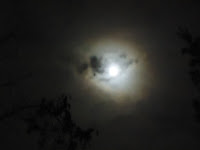We credit artists with an ability to see somehow differently than the rest of us, as if they have some special sort of vision. I am not arguing that they don’t have certain special gifts or abilities or insights; they do. I cannot help but notice however, that the great pre-Impressionist artists painted to the best of their abilities what they saw, interpreting their own visual reality onto canvas. Their attempts to capture the fleeting reality of the effects of light mark their work.
When an artist paints a sky, presumably he looks up and paints what he sees, or has seen in the past which might suit the painting’s theme. I cite four examples here that I find striking, and admit having noticed many others in galleries around the world.
Titian has successfully captured the wistful layers and streaks of the late summer Tuscan sky in his Sacred and Profane Love at the Borghese Gallery in Rome.

You can see the same light effects today: here a photo I took of the view from the Pope’s Hanging Garden in Pienza, Italy. Looks like Titian’s sky, doesn’t it?
A generation later in Spain, we find El Greco painting skies unlike anything in Italy. Long an El Greco fan, I once thought his skies were fantasies which presaged abstraction, as in his famous “View of Toledo.”
However, a trip to Toledo, Spain taught me that those crazy swirls which animate El Greco’s canvases were real, the same crazy, swirly, animated Spanish skies you can still see there today as in this fantasic photo of Toledo by David Iliff.
Moving north and to the 18th century, there’s England’s John Constable, who was known for his clouds, skies and light effects. The same Constable who gave us tons of paintings called “Cloud Studies” as part of his oeuvre, including a few at the Frick in New York and the National Gallery, Washington whose collections also include “The White Horse” and “Wivenhoe Park, Essex,” shown here.

His clouds are those fluffy, cottony white English clouds you can still see today on any brisk stroll across Millenium Bridge in London.
Big, fat, bucolic English clouds skip as lively across his paintings as they do the River Thames today.

But the painter of whom I was reminded during last night’s full moon was Rembrandt. Living in his city, I am struck by how often the Amsterdam sky looks like Rembrandt’s skies, and never more so than during a full moon. Where did Rembrandt learn about what the sky would look like at Christ’s ascension? 
Clearly he had not witnessed the event firsthand, but he had seen the Dutch sky with the racing clouds leaving a halo of light around the moon and looking very much like a portal into heaven itself.

Since beginning my art history studies, I have many times noted that Rembrandt’s skies often have a brown tint. I have never seen this effect noted in any scholarly essay or museum catalogue, so I have credited it to darkening varnish on old canvases. But living in Amsterdam and seeing the sky night after night, and especially the full moon last night, I see that Rembrandt painted the sky he saw. The brown is actually there. Look at the ring around the moon in the photos I took last night: definitely brown, not old varnish.

So, while great artists do have a special gift, I reckon it is that of being able to translate the visual input from their real world experience onto a canvas for us to enjoy centuries later. They don’t necessarily see differently, Titian saw the same striated Tuscan sky I saw. El Greco contemplated the same swirly Spanish sky I did. Constable adored same the whipped cream clouds that float above the land of clotted cream today. Rembrandt gasped at the same drama in the Dutch sky that I saw last night. But in it, he saw the Resurrection of Christ.



And I know where you learned your appreciation of skies, your own native city, not much higher than Amsterdam and with a similarly intense relationship with the water. There is always great play going on between the water and sky here. I am glad I work outside so I can enjoy it.
ReplyDeleteThere was a disturbing article in the paper Sunday that listed Hampton Roads as one of the top ten cities worldwide whose assets are most threatened with sea level rise. We are also right behind New Orleans as the most at risk region in the States. Not only are the waters rising, but we are sinking as the land here rebounds from being pushed up by the weight of northern glaciers during the last ice age, like we are on the downward end of a giant seesaw. The aritcle said that locally the waters are 1.5' higher than they were a century ago, and that figure is projected to double by 2100 (I'm glad I will be dead then). What this has to do with your topic I am not sure, but I thought you may appreciate it.
And being who I am, I see abstract in most everything... the last moon shot appears to be a face to me, with one black eye somewhat protruding, two dark nostrils and thin wispy lips with a pearl above above the lips, left of center. An omen it's not... my hallucination ? No, I was not planting morning glory seeds...
ReplyDelete